glove box Hyundai Accent 2009 Owner's Manual
[x] Cancel search | Manufacturer: HYUNDAI, Model Year: 2009, Model line: Accent, Model: Hyundai Accent 2009Pages: 266, PDF Size: 8.77 MB
Page 9 of 266
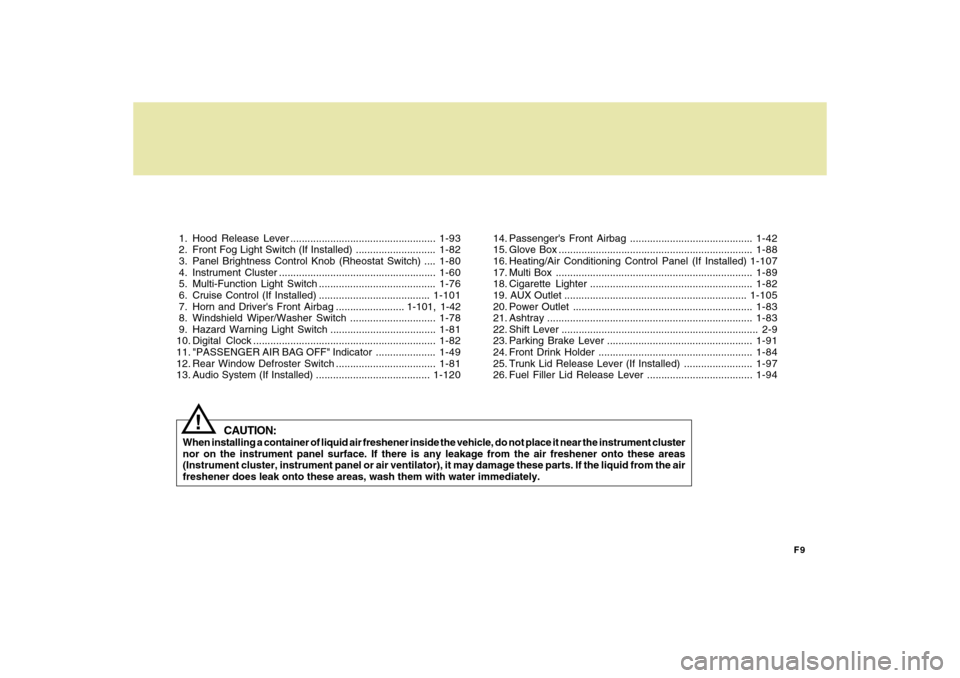
F9
1. Hood Release Lever ...................................................1-93
2. Front Fog Light Switch (If Installed) ............................1-82
3. Panel Brightness Control Knob (Rheostat Switch) ....1-80
4. Instrument Cluster .......................................................1-60
5. Multi-Function Light Switch .........................................1-76
6. Cruise Control (If Installed) .......................................1-101
7. Horn and Driver's Front Airbag ........................ 1-101, 1-42
8. Windshield Wiper/Washer Switch ..............................1-78
9. Hazard Warning Light Switch .....................................1-81
10. Digital Clock ................................................................1-82
11. "PASSENGER AIR BAG OFF" Indicator .....................1-49
12. Rear Window Defroster Switch ...................................1-81
13. Audio System (If Installed) ........................................1-12014. Passenger's Front Airbag ...........................................1-42
15. Glove Box ....................................................................1-88
16. Heating/Air Conditioning Control Panel (If Installed)1-107
17. Multi Box .....................................................................1-89
18. Cigarette Lighter .........................................................1-82
19. AUX Outlet ................................................................1-105
20. Power Outlet ...............................................................1-83
21. Ashtray........................................................................1-83
22. Shift Lever ..................................................................... 2-9
23. Parking Brake Lever ...................................................1-91
24. Front Drink Holder ......................................................1-84
25. Trunk Lid Release Lever (If Installed) ........................1-97
26. Fuel Filler Lid Release Lever .....................................1-94
CAUTION:
When installing a container of liquid air freshener inside the vehicle, do not place it near the instrument cluster
nor on the instrument panel surface. If there is any leakage from the air freshener onto these areas
(Instrument cluster, instrument panel or air ventilator), it may damage these parts. If the liquid from the air
freshener does leak onto these areas, wash them with water immediately.
!
Page 52 of 266
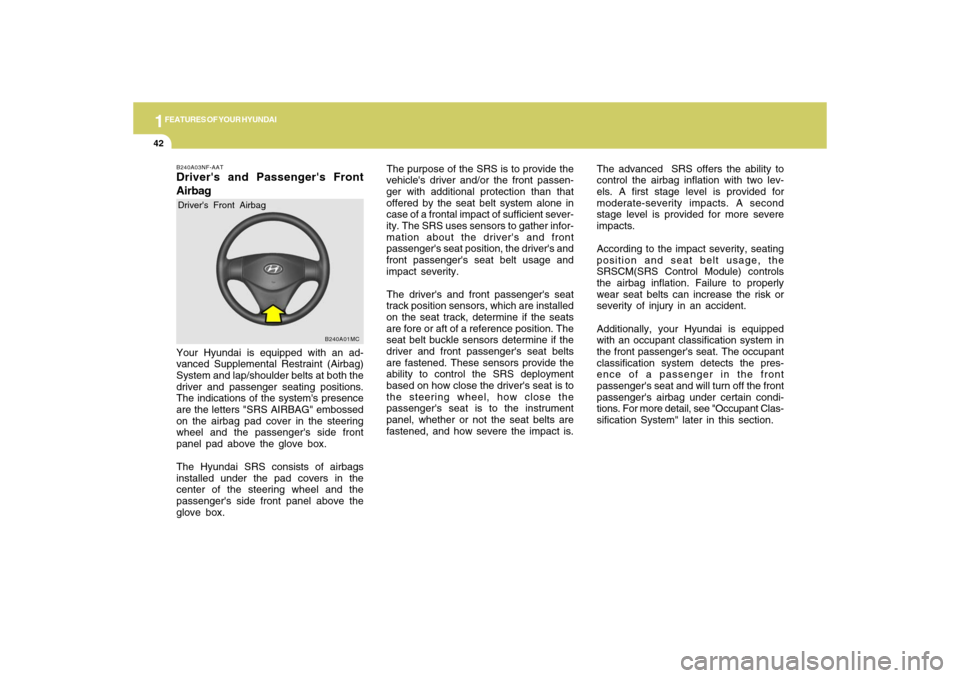
1FEATURES OF YOUR HYUNDAI42
B240A01MC
The purpose of the SRS is to provide the
vehicle's driver and/or the front passen-
ger with additional protection than that
offered by the seat belt system alone in
case of a frontal impact of sufficient sever-
ity. The SRS uses sensors to gather infor-
mation about the driver's and front
passenger's seat position, the driver's and
front passenger's seat belt usage and
impact severity.
The driver's and front passenger's seat
track position sensors, which are installed
on the seat track, determine if the seats
are fore or aft of a reference position. The
seat belt buckle sensors determine if the
driver and front passenger's seat belts
are fastened. These sensors provide the
ability to control the SRS deployment
based on how close the driver's seat is to
the steering wheel, how close the
passenger's seat is to the instrument
panel, whether or not the seat belts are
fastened, and how severe the impact is.The advanced SRS offers the ability to
control the airbag inflation with two lev-
els. A first stage level is provided for
moderate-severity impacts. A second
stage level is provided for more severe
impacts.
According to the impact severity, seating
position and seat belt usage, the
SRSCM(SRS Control Module) controls
the airbag inflation. Failure to properly
wear seat belts can increase the risk or
severity of injury in an accident.
Additionally, your Hyundai is equipped
with an occupant classification system in
the front passenger's seat. The occupant
classification system detects the pres-
ence of a passenger in the front
passenger's seat and will turn off the front
passenger's airbag under certain condi-
tions. For more detail, see "Occupant Clas-
sification System" later in this section.
B240A03NF-AATDriver's and Passenger's Front
AirbagYour Hyundai is equipped with an ad-
vanced Supplemental Restraint (Airbag)
System and lap/shoulder belts at both the
driver and passenger seating positions.
The indications of the system's presence
are the letters "SRS AIRBAG" embossed
on the airbag pad cover in the steering
wheel and the passenger's side front
panel pad above the glove box.
The Hyundai SRS consists of airbags
installed under the pad covers in the
center of the steering wheel and the
passenger's side front panel above the
glove box.Driver's Front Airbag
Page 55 of 266
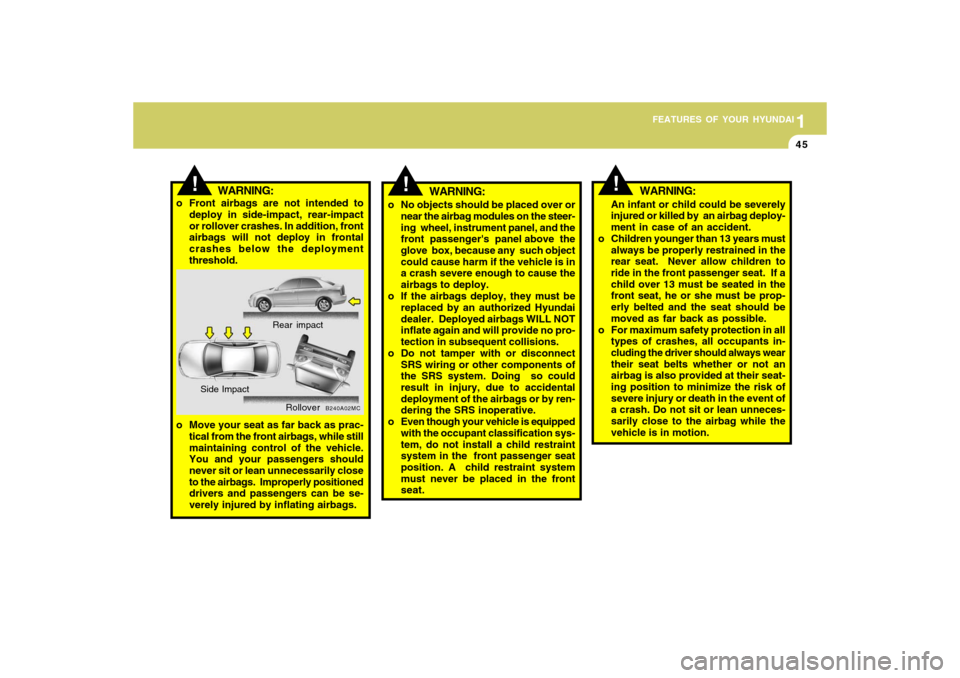
1
FEATURES OF YOUR HYUNDAI
451
FEATURES OF YOUR HYUNDAI
45
!
WARNING:
o No objects should be placed over or
near the airbag modules on the steer-
ing wheel, instrument panel, and the
front passenger's panel above the
glove box, because any such object
could cause harm if the vehicle is in
a crash severe enough to cause the
airbags to deploy.
o If the airbags deploy, they must be
replaced by an authorized Hyundai
dealer. Deployed airbags WILL NOT
inflate again and will provide no pro-
tection in subsequent collisions.
o Do not tamper with or disconnect
SRS wiring or other components of
the SRS system. Doing so could
result in injury, due to accidental
deployment of the airbags or by ren-
dering the SRS inoperative.
o Even though your vehicle is equipped
with the occupant classification sys-
tem, do not install a child restraint
system in the front passenger seat
position. A child restraint system
must never be placed in the front
seat.
An infant or child could be severely
injured or killed by an airbag deploy-
ment in case of an accident.
o Children younger than 13 years must
always be properly restrained in the
rear seat. Never allow children to
ride in the front passenger seat. If a
child over 13 must be seated in the
front seat, he or she must be prop-
erly belted and the seat should be
moved as far back as possible.
o For maximum safety protection in all
types of crashes, all occupants in-
cluding the driver should always wear
their seat belts whether or not an
airbag is also provided at their seat-
ing position to minimize the risk of
severe injury or death in the event of
a crash. Do not sit or lean unneces-
sarily close to the airbag while the
vehicle is in motion.!
WARNING:
!
WARNING:
B240A02MC
Rear impact
Side Impact
Rollover
o Front airbags are not intended to
deploy in side-impact, rear-impact
or rollover crashes. In addition, front
airbags will not deploy in frontal
crashes below the deployment
threshold.
o Move your seat as far back as prac-
tical from the front airbags, while still
maintaining control of the vehicle.
You and your passengers should
never sit or lean unnecessarily close
to the airbags. Improperly positioned
drivers and passengers can be se-
verely injured by inflating airbags.
Page 57 of 266
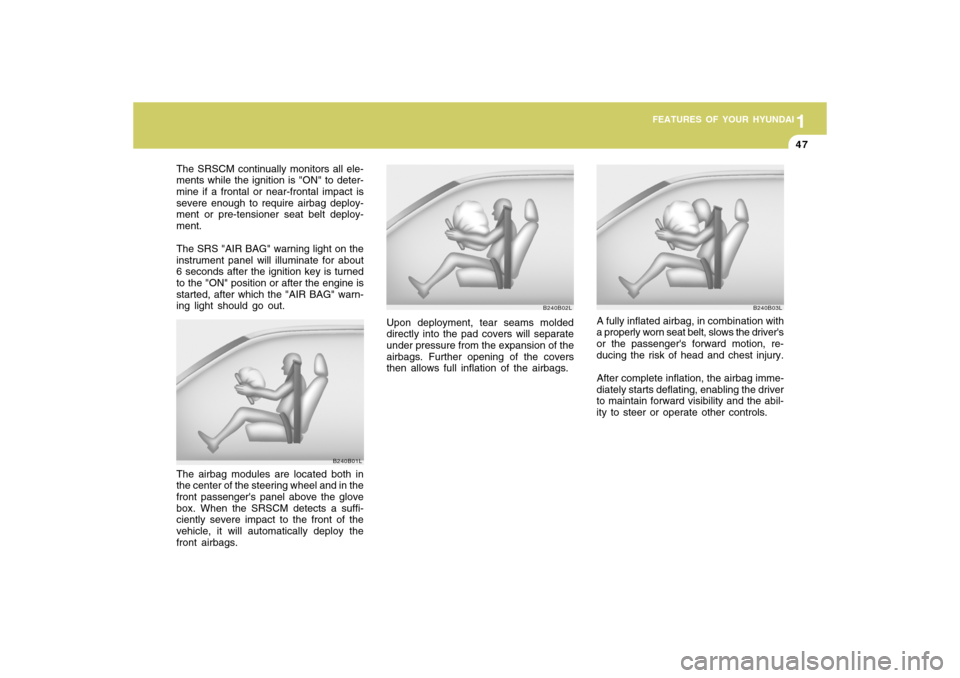
1
FEATURES OF YOUR HYUNDAI
471
FEATURES OF YOUR HYUNDAI
47
The SRSCM continually monitors all ele-
ments while the ignition is "ON" to deter-
mine if a frontal or near-frontal impact is
severe enough to require airbag deploy-
ment or pre-tensioner seat belt deploy-
ment.
The SRS "AIR BAG" warning light on the
instrument panel will illuminate for about
6 seconds after the ignition key is turned
to the "ON" position or after the engine is
started, after which the "AIR BAG" warn-
ing light should go out.
B240B01L
Upon deployment, tear seams molded
directly into the pad covers will separate
under pressure from the expansion of the
airbags. Further opening of the covers
then allows full inflation of the airbags.
The airbag modules are located both in
the center of the steering wheel and in the
front passenger's panel above the glove
box. When the SRSCM detects a suffi-
ciently severe impact to the front of the
vehicle, it will automatically deploy the
front airbags.
B240B02L
A fully inflated airbag, in combination with
a properly worn seat belt, slows the driver's
or the passenger's forward motion, re-
ducing the risk of head and chest injury.
After complete inflation, the airbag imme-
diately starts deflating, enabling the driver
to maintain forward visibility and the abil-
ity to steer or operate other controls.
B240B03L
Page 58 of 266
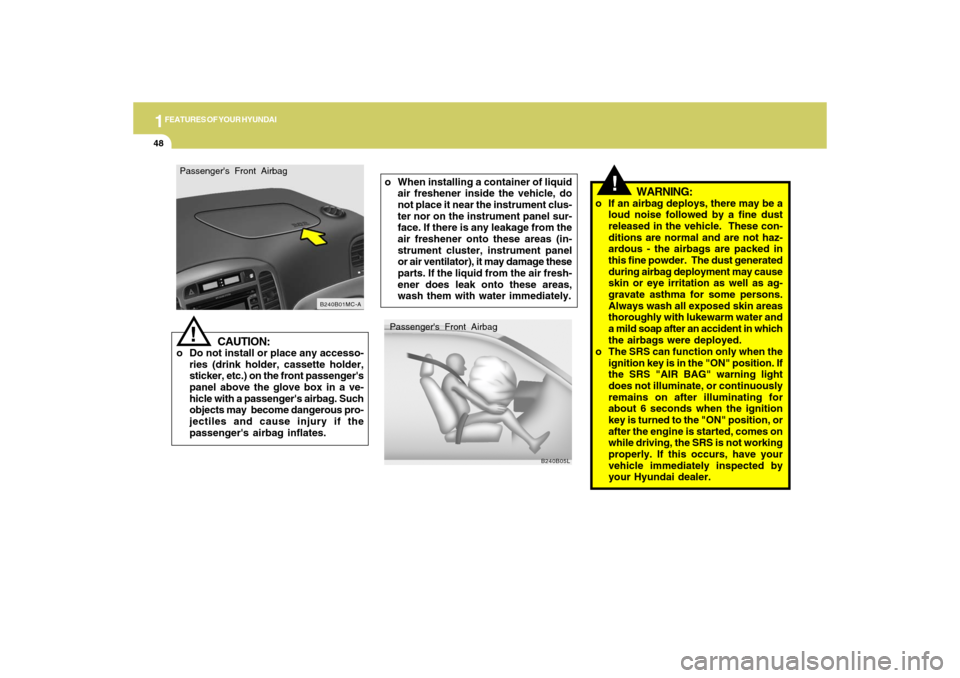
1FEATURES OF YOUR HYUNDAI48
!
Passenger's Front Airbag
B240B05L
o When installing a container of liquid
air freshener inside the vehicle, do
not place it near the instrument clus-
ter nor on the instrument panel sur-
face. If there is any leakage from the
air freshener onto these areas (in-
strument cluster, instrument panel
or air ventilator), it may damage these
parts. If the liquid from the air fresh-
ener does leak onto these areas,
wash them with water immediately.
WARNING:
o If an airbag deploys, there may be a
loud noise followed by a fine dust
released in the vehicle. These con-
ditions are normal and are not haz-
ardous - the airbags are packed in
this fine powder. The dust generated
during airbag deployment may cause
skin or eye irritation as well as ag-
gravate asthma for some persons.
Always wash all exposed skin areas
thoroughly with lukewarm water and
a mild soap after an accident in which
the airbags were deployed.
o The SRS can function only when the
ignition key is in the "ON" position. If
the SRS "AIR BAG" warning light
does not illuminate, or continuously
remains on after illuminating for
about 6 seconds when the ignition
key is turned to the "ON" position, or
after the engine is started, comes on
while driving, the SRS is not working
properly. If this occurs, have your
vehicle immediately inspected by
your Hyundai dealer.
Passenger's Front Airbag
CAUTION:
o Do not install or place any accesso-
ries (drink holder, cassette holder,
sticker, etc.) on the front passenger's
panel above the glove box in a ve-
hicle with a passenger's airbag. Such
objects may become dangerous pro-
jectiles and cause injury if the
passenger's airbag inflates.
!
B240B01MC-A
Page 68 of 266
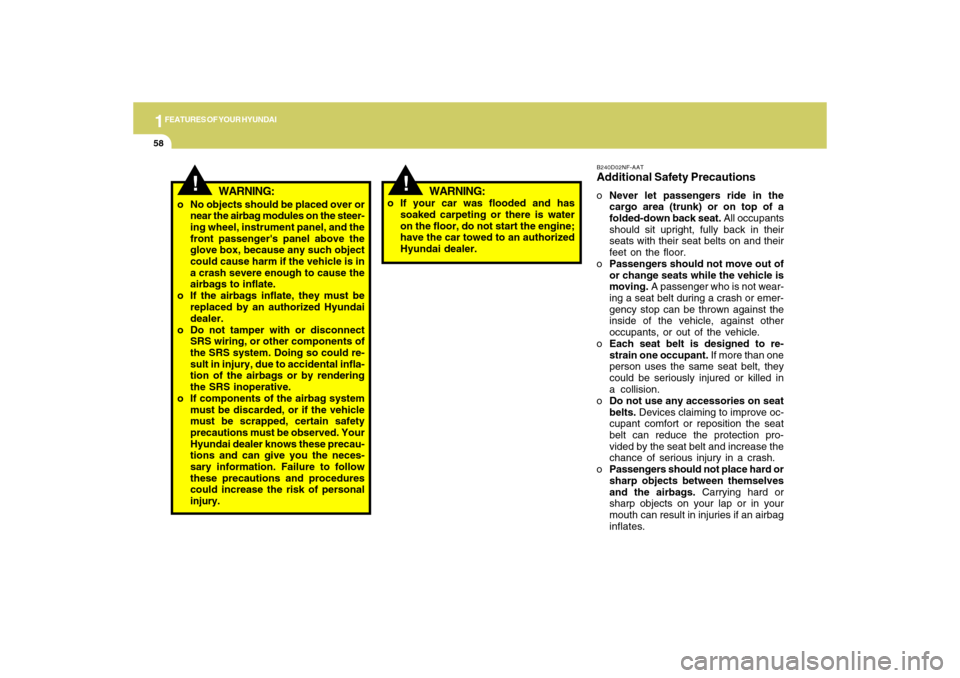
1FEATURES OF YOUR HYUNDAI58
B240D02NF-AATAdditional Safety PrecautionsoNever let passengers ride in the
cargo area (trunk) or on top of a
folded-down back seat. All occupants
should sit upright, fully back in their
seats with their seat belts on and their
feet on the floor.
oPassengers should not move out of
or change seats while the vehicle is
moving. A passenger who is not wear-
ing a seat belt during a crash or emer-
gency stop can be thrown against the
inside of the vehicle, against other
occupants, or out of the vehicle.
oEach seat belt is designed to re-
strain one occupant. If more than one
person uses the same seat belt, they
could be seriously injured or killed in
a collision.
oDo not use any accessories on seat
belts. Devices claiming to improve oc-
cupant comfort or reposition the seat
belt can reduce the protection pro-
vided by the seat belt and increase the
chance of serious injury in a crash.
oPassengers should not place hard or
sharp objects between themselves
and the airbags. Carrying hard or
sharp objects on your lap or in your
mouth can result in injuries if an airbag
inflates.
!
WARNING:
o No objects should be placed over or
near the airbag modules on the steer-
ing wheel, instrument panel, and the
front passenger's panel above the
glove box, because any such object
could cause harm if the vehicle is in
a crash severe enough to cause the
airbags to inflate.
o If the airbags inflate, they must be
replaced by an authorized Hyundai
dealer.
o Do not tamper with or disconnect
SRS wiring, or other components of
the SRS system. Doing so could re-
sult in injury, due to accidental infla-
tion of the airbags or by rendering
the SRS inoperative.
o If components of the airbag system
must be discarded, or if the vehicle
must be scrapped, certain safety
precautions must be observed. Your
Hyundai dealer knows these precau-
tions and can give you the neces-
sary information. Failure to follow
these precautions and procedures
could increase the risk of personal
injury.
!
WARNING:
o If your car was flooded and has
soaked carpeting or there is water
on the floor, do not start the engine;
have the car towed to an authorized
Hyundai dealer.
Page 98 of 266

1FEATURES OF YOUR HYUNDAI88
!GLOVE BOX
WARNING:
To avoid the possibility of injury in case
of an accident or a sudden stop, the
glove box door should be kept closed
when the car is in motion.B500A01A-AAT
B500A01MC
o To open the glove box, pull on the
glove box release lever.
o"ON"In the "ON" position, the light stays on at
all times.
CAUTION:
Do not leave the switch in this position
for an extended period of time when the
vehicle is not running.
!
SUNGLASS HOLDER!
B491A03O-AAT(If Installed)The sunglass holder is located on the
front overhead console. Push the end of
the cover to open the sunglass holder.
WARNING:
o Do not keep objects except sunglass
inside the sunglass holder. Such ob-
jects can be thrown from the holder
in the event of a sudden stop or an
accident, possibly injuring the pas-
sengers in the vehicle.
o Do not open the sunglass holder while
the vehicle is moving. The rear view
mirror of the vehicle can be blocked
by an open sunglass holder.
B491A03MC
o "OFF"In the "OFF" position, the light stays off at
all times even though a door is open.
Page 126 of 266

1FEATURES OF YOUR HYUNDAI
116
!
CAUTION:
o Replace the filter every 10,000 miles
(15,000 km) or once a year. If the car
is being driven in severe conditions
such as dusty, rough roads, more
frequent climate control air filter in-
spections and changes are required.
o When the air flow rate is decreased,
the system should be checked at an
authorized dealer.
CLIMATE CONTROL AIR
FILTER
B760A01MC
Inside of
a vehicle
Evaporator coreFilter Blower
Outside air
Inside air
The climate control air filter is located in
front of the evaporator unit behind the
glove box.
It operates to decrease the amount of
pollutants entering the car.
To replace the climate control air filter,
refer to the page 6-15.B760A07A-AAT(For evaporator and blow unit)
Page 198 of 266
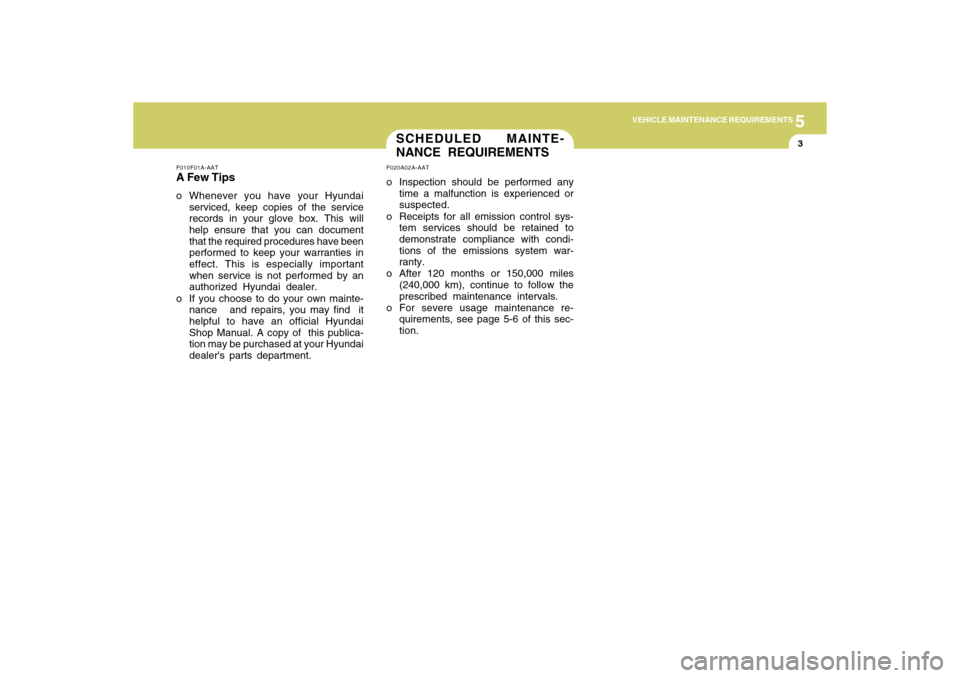
5
VEHICLE MAINTENANCE REQUIREMENTS
3
SCHEDULED MAINTE-
NANCE REQUIREMENTSF020A02A-AATo Inspection should be performed any
time a malfunction is experienced or
suspected.
o Receipts for all emission control sys-
tem services should be retained to
demonstrate compliance with condi-
tions of the emissions system war-
ranty.
o After 120 months or 150,000 miles
(240,000 km), continue to follow the
prescribed maintenance intervals.
o For severe usage maintenance re-
quirements, see page 5-6 of this sec-
tion.
F010F01A-AATA Few Tipso Whenever you have your Hyundai
serviced, keep copies of the service
records in your glove box. This will
help ensure that you can document
that the required procedures have been
performed to keep your warranties in
effect. This is especially important
when service is not performed by an
authorized Hyundai dealer.
o If you choose to do your own mainte-
nance and repairs, you may find it
helpful to have an official Hyundai
Shop Manual. A copy of this publica-
tion may be purchased at your Hyundai
dealer's parts department.
Page 220 of 266
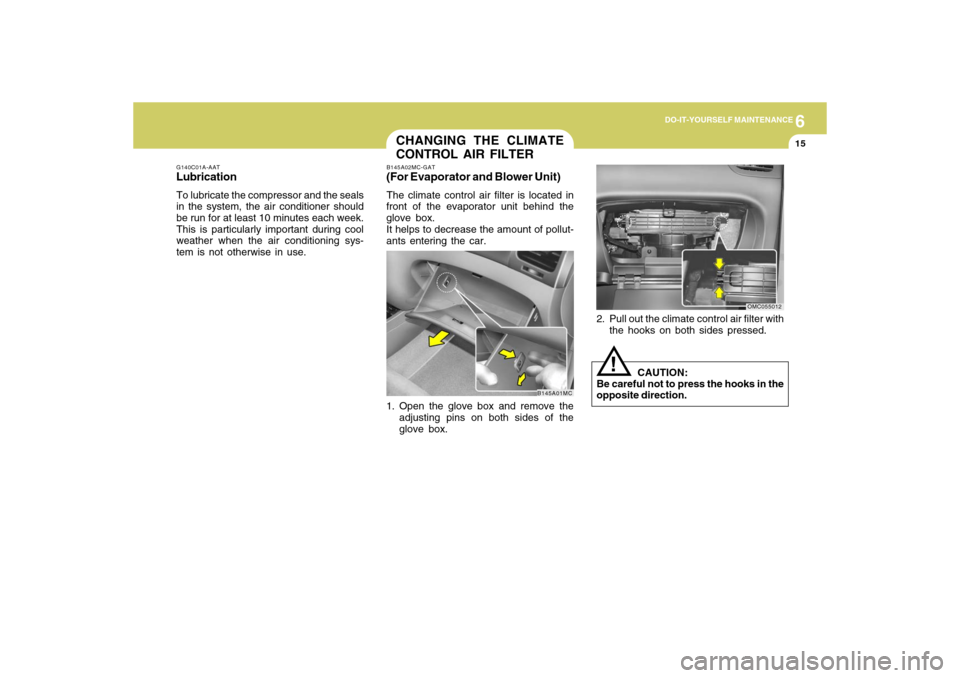
6
DO-IT-YOURSELF MAINTENANCE
15
G140C01A-AATLubricationTo lubricate the compressor and the seals
in the system, the air conditioner should
be run for at least 10 minutes each week.
This is particularly important during cool
weather when the air conditioning sys-
tem is not otherwise in use.
2. Pull out the climate control air filter with
the hooks on both sides pressed.
CAUTION:
Be careful not to press the hooks in the
opposite direction.
!
CHANGING THE CLIMATE
CONTROL AIR FILTERB145A02MC-GAT(For Evaporator and Blower Unit)The climate control air filter is located in
front of the evaporator unit behind the
glove box.
It helps to decrease the amount of pollut-
ants entering the car.
1. Open the glove box and remove the
adjusting pins on both sides of the
glove box.
B145A01MC
OMC055012